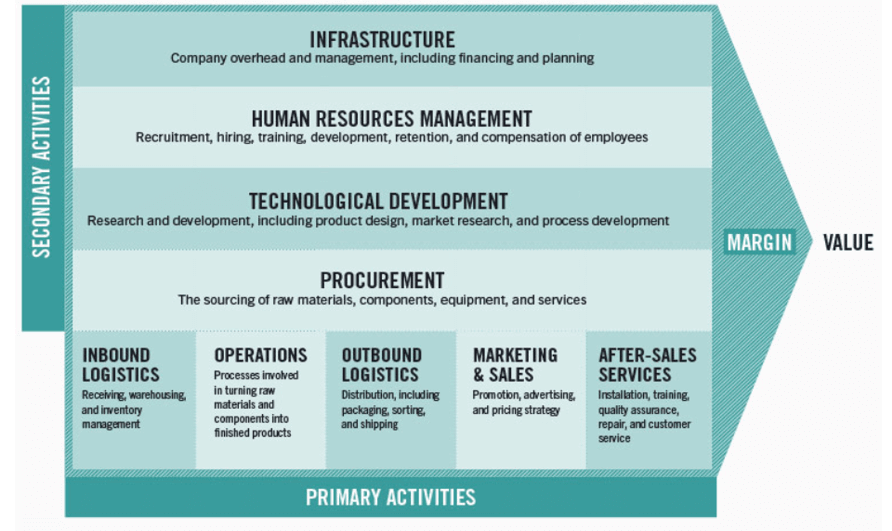The concept of Value Chain on marketing refers to the various business activities and processes in creating a product or performing a service.
A value chain can consist of multiple stages of a product or service’s lifecycle, including research and development, sales, and everything in between.
Harvard Business School Professor Michael Porter conceived the concept in his book: The Competitive Advantage: Creating and Sustaining Superior Performance.
The value Chain consists of two types of Activities
Primary Activities
Those that go directly into the creation of a product or the execution of a service
- Inbound logistics: Activities related to receiving, warehousing, and inventory management of source materials and components
- Operations: Activities related to turning raw materials and components into a finished product
- Outbound logistics: Activities related to distribution, including packaging, sorting, and shipping
- Marketing and sales: Activities related to the marketing and sale of a product or service, including promotion, advertising, and pricing strategy
- After-sales services: Activities that take place after a sale has been finalized, including installation, training, quality assurance, repair, and customer service
Secondary Activities
Help primary activities become more efficient – effectively creating a competitive advantage.
- Procurement: Activities related to the sourcing of raw materials, components, equipment, and services
- Technological Development: Activities related to research and development, including product design, market research, and process development
- Human Resources Management: Activities related to the recruitment, hiring, training, development, retention, and compensation of employees
- Infrastructure: Activities related to the company’s overhead and management, including financing and planning

Value Chain Analysis
Evaluating each of the activities in a company’s value chain to understand where opportunities for improvement lie
Conducting a value chain analysis prompts you to consider how each step adds or subtracts value from your final product or service.
Value Chain Analysis helps you answer:
- How to differentiate yourself from your competitors
- How to provide the most value to your customers
- How to increase revenue and profits
- How to improve operations efficiency
How to Conduct a Value Chain Analysis
Conducting a value chain analysis involves a systematic process to identify, assess, and optimize the activities contributing to creating value within your business. Here’s a step-by-step guide:
- Identify Activities: Identify all the activities involved in creating and delivering your product or service. These activities can be categorized into primary and support activities.
- Map the Value Chain: Create a visual representation of the value chain, outlining the sequence of activities from raw materials to the final product/service delivery.
- Assess Value: Evaluate each activity’s impact on the final product’s value and customer satisfaction. Consider factors such as quality, efficiency, and uniqueness.
- Analyze Costs: Determine the costs associated with each activity. This includes direct costs (e.g., raw materials) and indirect costs (e.g., overhead).
- Competitive Advantage: Identify areas where your business excels compared to competitors. These areas could be due to cost advantages or unique value-added features.
- Opportunities and Weaknesses: Identify activities where you can improve efficiency, reduce costs, or enhance value. Also, pinpoint areas where your business might be lagging or facing challenges.
- Benchmarking: Compare your value chain to competitors or industry best practices to understand where you stand and what improvements are possible.
- Technological Advancements: Evaluate how technology can improve various activities within the value chain, leading to increased efficiency and innovation.
- Collaboration: Consider partnerships or collaborations to optimize certain activities. Outsourcing non-core activities might be beneficial.
- Cost-Value Trade-offs: Make strategic decisions about where to allocate resources. Sometimes, investing more in certain activities can lead to significant value creation downstream.
- Continuous Improvement: Value chain analysis is an ongoing process. Regularly review and update your analysis to adapt to changes in the market, technology, and customer preferences.
- Implementation: Execute the identified improvements and changes systematically. Monitor the results and make further adjustments as needed.

Remember that a value chain analysis aims to enhance efficiency and create a competitive advantage. It requires thorough understanding of your industry, market dynamics, and company strengths and weaknesses.
Key Takeaways from the concept of value chain in marketing
- A value chain is a step-by-step business model for transforming a product or service from idea to reality.
- Value chains help increase a business’s efficiency to deliver the most value for the least possible cost.
- The end goal of a value chain is to create a competitive advantage for a company by increasing productivity while keeping costs reasonable.
- The value-chain theory analyzes a firm’s five primary and four support activities.
Professor of Marketing & an esteemed alumnus of IIM Ahmedabad, Dr. Saxena holds a Ph.D. in Brand Management, which garnered him the prestigious Best Ph.D. Thesis award. Recognized for his exceptional contributions to academia, Dr. Saxena has been honored with the Young Faculty by CEGR. Additionally, he received the “Best Professor in Marketing Analytics” award.